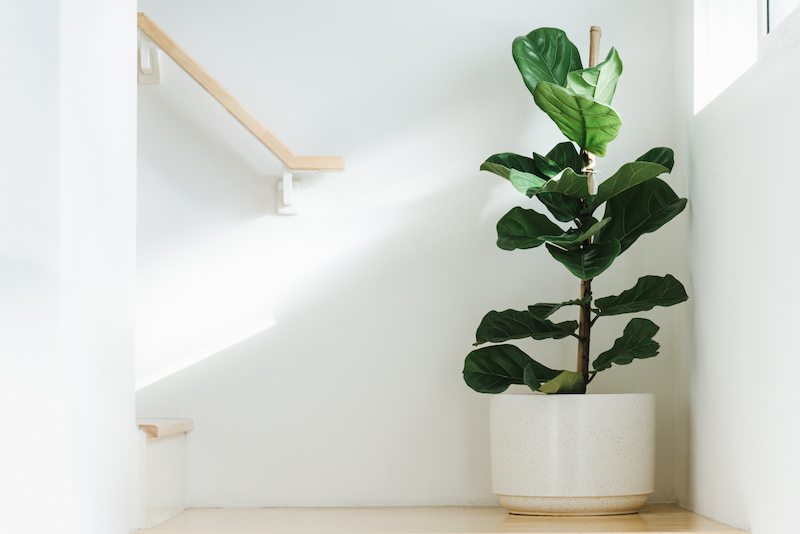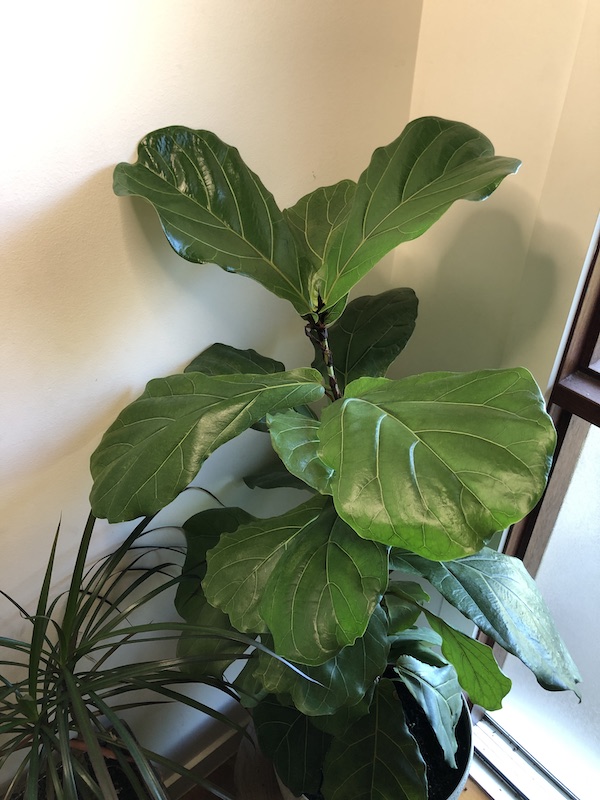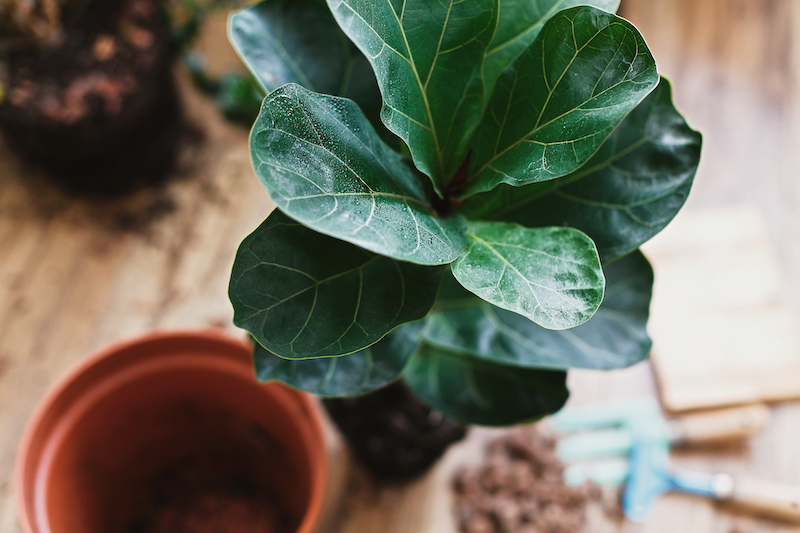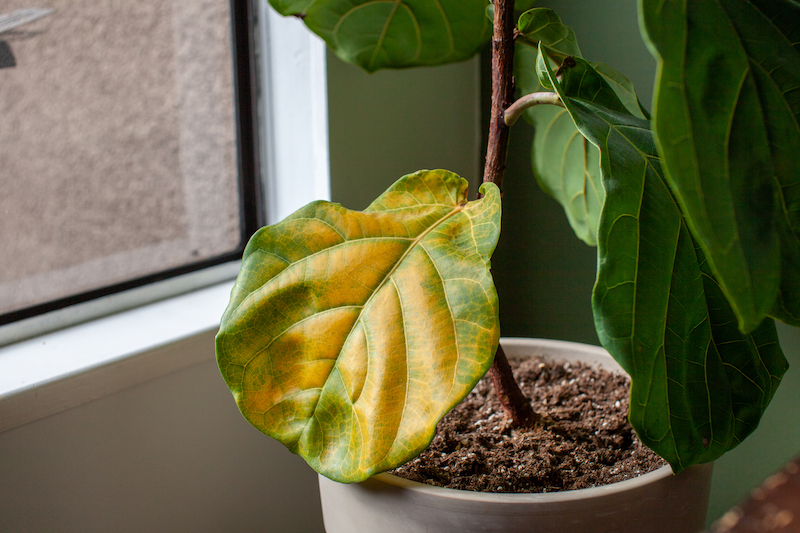If you are looking to add a touch of nature to your home or indoor workplace, consider a fiddle leaf fig for a striking specimen plant or as the focal point of an indoor garden. Also known botanically as the Ficus lyrata, we’ll provide you with all the information and Ficus lyrata care tips to help you care for your plant to see it thrive.
General Description of a Fiddle Leaf Fig
Fiddle leaf (Ficus lyrata) is an export of the famous West African rainforests, originating somewhere between Sierra Leone and Cameroon. In its natural environment it can grow into quite a large, beautiful tree and it does flower and produce fruit, however this is much less common when kept indoors.
The fiddle leaf fig light requirements allow it to grow happily indoors making it quite a common house plant. Its leaves are broad, with curved or wavy edges and have the shape of a ‘fiddle’ hence the name. The leaves are generally dark green and quite leathery and can grow up to 40cm in length. Being so large they will benefit from the occasional wipe over with a damp cloth, or can be given a shower, to remove any dust they may catch. The network of veins on the leaf is clearly visible and forms a unique arrangement.
The F. lyrata ‘bambino’ and ‘suncoast’ cultivars are smaller and bushier varieties of the traditional fiddle leaf fig (Ficus lyrata), but the main F. lyrata variety is the one you’re most likely to find. They belong to the same family as Ficus elastica, also known as the rubber plant.
Many interior design magazines feature fiddle leaf figs on their pages. Their dark green leaves and tall structure make them sought after as they create a stylish focal point for designers and photographers. The fiddle leaf fig (Ficus lyrata) is really quite iconic in its appearance.
Ficus lyrata Care Guide
Our Ficus lyrata care guide will prepare you with the right information to provide the best indoor environment for your plant. So if your fiddle leaf fig dropping leaves is concerning you, keep reading. Here’s a few things you can consider:
Light
Fiddle leaf fig light requirements are easy to provide for indoors. A bright spot in your home will be best with your fiddle leaf fig being able to tolerate a small amount of direct sunlight each day. Placing your plant near a window or in a bright room will provide the right light. Mine sits by the front door where it gets the morning sun and then is well lit for the rest of the day.

Like all plants, your fiddle leaf fig will grow towards the direction of the sunlight. From time to time, say every few weeks, you can rotate your pot with a ¼ turn so that your plant grows straight and tall. Hopefully you can find a spot in your home or office to cater for the fiddle leaf fig light needs.
Water
Watering is very important in Ficus lyrata care. When watering your fiddle leaf fig use lukewarm water or water at room temperature. Allow the soil surface to dry out slightly before you give it a drink.

While fiddle leaf fig plants can be thirsty, especially with their large leaves as they grow, waterlogged soil won’t help their growth. Waterlogged soil does make the plant susceptible to root rot which could be a factor if your fiddle leaf fig is dropping leaves. Overwatering will cause more damage than underwatering as they are quite tolerant of drought and dry conditions.
And if you realise you have lovingly overwatered your plant and your fiddle leaf fig is dropping leaves, pause the watering, make sure it has plenty of light, let the soil dry out and it will have a good chance of recovering. A soil moisture meter can be particularly helpful if your plant is in a larger pot and you are unsure of how wet it is at the bottom.
Temperature
Fiddle leaf figs are a tropical plant and do prefer warmer temperatures, frosts can be quite damaging for them. Ideally it is better to grow it in a place where the winter temperature stays above 10°C or 50°F. You can always change the location of your fiddle leaf fig to place it in a more suitable temperature, depending on what you have in your surroundings. Once settled in, try not to move your plant around too much as it will adapt to the environment where you position it.
Fertilizer
Plants with large leaves like the fiddle leaf fig are plants that generally require sufficient levels of nutrients in the soil for optimal growth and health. Ensure the soil you plant your Ficus lyrata in has enough nutrients. You can mulch the soil and use a seaweed-based fertilizer for optimum growth. Indoor plant fertilizers are specifically designed for houseplants and adding fertilizer to your Ficus lyrata care routine will probably enhance its growth. Always be sure to follow the manufacturer’s instructions. Under fertilizing is less harmful than over fertilizing.
Pruning
Your fiddle leaf fig can become quite tall but pruning will help control this. Prune them by removing the tip growth or by removing the lower leaves, depending on the shape you are wanting to create. If you cut the stem above a leaf node this may encourage new growth from the node which could help to reshape your fiddle leaf fig. The best time to prune your fiddle leaf is during the growing season of spring and summer.
Planting Guide for Ficus lyrata Care
In selecting the soil for your fiddle leaf be sure to choose a well-draining soil so that your plant won’t become waterlogged. Garden soil is suitable as long as it is moist, humus-rich, and well-draining. Potting mixes do provide the best option for houseplants and a premium quality potting mix will contain all the nutrients a plant needs for the first 6-12 months.

When repotting fiddle leaf figs, don’t be too hasty. Every couple of years you can repot your plant, usually spring is the best time so it can resettle during the warmer weather. A seaweed extract is also ideal to add when you repot as it acts as a tonic for the plant and helps to promote new root growth.
Be careful using self-watering pots with fiddle leaf figs as they can result in too much water in the bottom of the soil, leading to root rot. Combined with this, the fiddle leaf fig light requirements can be tricky, but very rewarding when your fiddle leaf fig is happy with its environment and starts putting out new leaves.
Problems That Fiddle Leaf Figs Can Be Susceptible To
For optimal Ficus lyrata care, it is recommended to keep your fiddle leaf fig away from artificial air surroundings like the air conditioner and heater. Fiddle leaf figs can be sensitive to changes in humidity, and sometimes may benefit from some misting to increase humidity. Brown spots may start to appear on the body of the leaf if they are being affected by humidity.
As previously discussed, repotting a fiddle leaf fig in the right soil is very important to prevent root rot. If this occurs you may find your fiddle leaf starting to drop its lower leaves. This can also happen naturally from old age or if your plant is not receiving enough light or nutrients.
Too much direct sunlight may cause the leaves to ‘burn’ so if you notice this happening, move your plant to a location with more indirect light.

Toxicity
Fiddle leaf figs can be dangerous to pets in and around the house. While they are floor plants, you can take extra measures to keep them away from your pets. Fiddle leaves are generally not toxic to humans, but the sap can cause skin irritation and it is advised that they are kept away from young children.
Ficus lyrata Care Do’s and Don’ts
Fiddle-leaf figs can be a beautiful addition to any home or office space and require little care once they are established. Here is our short summary of our best tips for Ficus lyrata care:
Do’s
- wipe the leaves occasionally
- protect from long periods of exposure to direct sunlight
- fertilize during the growing season
Don’ts
- Overwater
- Repot too frequently
- Place your plant too near artificial heating or cooling.
Fiddle leaf figs are one of our highly recommended indoor plants that you can add to your home. Not only are they beautiful but they are quite hardy and will recover from some neglect or mistreatment. Following the Ficus lyrata care tips you have just read will have you well on your way to a healthy, thriving plant that is sure to bring you joy as you care for it and watch it grow.




